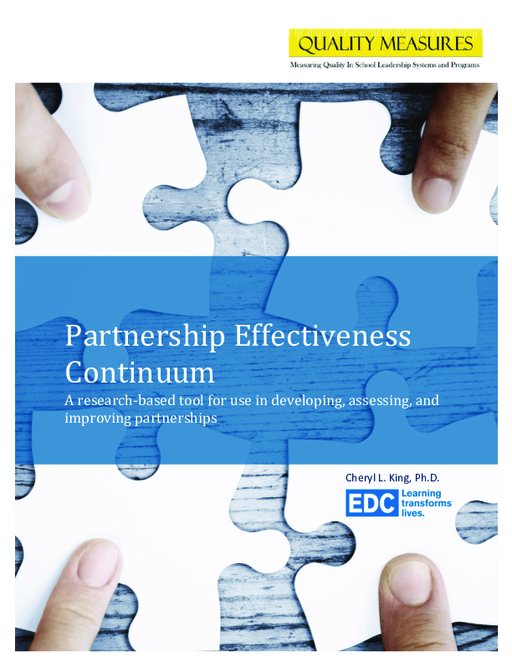Breadcrumb
- Wallace
- Reports
- Quality Measures: Partnership Ef...
Quality Measures: Partnership Effectiveness Continuum

- Author(s)
- C.L. King
- Publisher(s)
- Education Development Center, Inc.
Summary
How we did this
Researchers conducted a review of the literature to identify key papers that describe the characteristics of effective partnerships between school districts and others, especially educator training programs. Their work followed efforts by a professional learning community of people from principal training programs and school districts. The group had assembled an initial list of indicators of successful partnerships between districts and providers. The learning community was part of Wallace's Principal Pipeline Initiative.
Research on school leader preparation programs suggests that programs are more effective when school districts and training providers work together to improve principal performance.
How can such partnerships be forged and strengthened? The Partnership Effectiveness Continuum (PEC) tool is meant to help guide district-training provider discussion and planning so districts and programs can work together constructively.
The PEC can be used to guide the self-assessment of an existing partnership, or to support the development of a new partnership. It can be used to gauge partnerships in areas such as the quality of their communications and collaboration, as well as to assist partners in building trust and leveraging resources to focus on joint improvement strategies.

Both school districts and program providers recognize that if properly nurtured, partnerships can provide fertile soil for improving the impact of preparation and training on school leaders' performance.
Key Takeaways
The Partnership Effectiveness Continuum (PEC) is meant to help guide district-training provider discussion and planning so that districts and programs can work together constructively. It can be used to gauge partnerships in areas like the quality of their communications and collaboration.
The tool is organized around six dimensions of effective partnerships:
- Partnership vision
- Institutional leadership
- Joint ownership and accountability for results
- Communication and collaboration
- System alignment, integration, and sustainability
- Response to local context
It is important that leaders with decision-making authority from each partner organizations participate in the initial self-assessment process to establish a baseline and to emphasize the value of creating a shared vision for sustaining effective partnerships.

